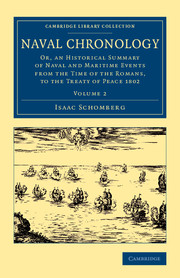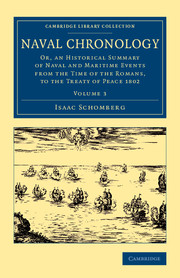Refine search
Actions for selected content:
15418 results in Military history

Naval Chronology
- Or, an Historical Summary of Naval and Maritime Events from the Time of the Romans, to the Treaty of Peace 1802
-
- Published online:
- 05 June 2015
- Print publication:
- 29 January 2015

The Chinese and their Rebellions
- Viewed in Connection with their National Philosophy, Ethics, Legislation, and Administration
-
- Published online:
- 05 June 2015
- Print publication:
- 01 January 2015
- First published in:
- 1856

Women and Yugoslav Partisans
- A History of World War II Resistance
-
- Published online:
- 05 June 2015
- Print publication:
- 12 May 2015

Directions for Sailing to and from the East Indies, China, New Holland, Cape of Good Hope, and the Interjacent Ports
- Compiled Chiefly from Original Journals at the East India House
-
- Published online:
- 05 June 2015
- Print publication:
- 20 November 2014

Naval Chronology
- Or, an Historical Summary of Naval and Maritime Events from the Time of the Romans, to the Treaty of Peace 1802
-
- Published online:
- 05 June 2015
- Print publication:
- 29 January 2015

Naval Chronology
- Or, an Historical Summary of Naval and Maritime Events from the Time of the Romans, to the Treaty of Peace 1802
-
- Published online:
- 05 June 2015
- Print publication:
- 29 January 2015
3 - The Faithful in Arms
-
- Book:
- God and Uncle Sam
- Published by:
- Boydell & Brewer
- Published online:
- 02 March 2024
- Print publication:
- 21 May 2015, pp 244-316
-
- Chapter
- Export citation
Contents
-
- Book:
- God and Uncle Sam
- Published by:
- Boydell & Brewer
- Published online:
- 02 March 2024
- Print publication:
- 21 May 2015, pp vii-vii
-
- Chapter
- Export citation
Chronology
-
- Book:
- God and Uncle Sam
- Published by:
- Boydell & Brewer
- Published online:
- 02 March 2024
- Print publication:
- 21 May 2015, pp xix-xxiv
-
- Chapter
- Export citation
Index
-
- Book:
- God and Uncle Sam
- Published by:
- Boydell & Brewer
- Published online:
- 02 March 2024
- Print publication:
- 21 May 2015, pp 689-704
-
- Chapter
- Export citation
Conclusion
-
- Book:
- God and Uncle Sam
- Published by:
- Boydell & Brewer
- Published online:
- 02 March 2024
- Print publication:
- 21 May 2015, pp 591-600
-
- Chapter
- Export citation
6 - Religion, War and Morality
-
- Book:
- God and Uncle Sam
- Published by:
- Boydell & Brewer
- Published online:
- 02 March 2024
- Print publication:
- 21 May 2015, pp 511-590
-
- Chapter
- Export citation
Introduction
-
- Book:
- God and Uncle Sam
- Published by:
- Boydell & Brewer
- Published online:
- 02 March 2024
- Print publication:
- 21 May 2015, pp 1-46
-
- Chapter
- Export citation
Notes
-
- Book:
- God and Uncle Sam
- Published by:
- Boydell & Brewer
- Published online:
- 02 March 2024
- Print publication:
- 21 May 2015, pp 601-656
-
- Chapter
- Export citation
List of Illustrations
-
- Book:
- God and Uncle Sam
- Published by:
- Boydell & Brewer
- Published online:
- 02 March 2024
- Print publication:
- 21 May 2015, pp viii-x
-
- Chapter
- Export citation
Abbreviations
-
- Book:
- God and Uncle Sam
- Published by:
- Boydell & Brewer
- Published online:
- 02 March 2024
- Print publication:
- 21 May 2015, pp xvii-xviii
-
- Chapter
- Export citation
2 - Religion and American Military Culture
-
- Book:
- God and Uncle Sam
- Published by:
- Boydell & Brewer
- Published online:
- 02 March 2024
- Print publication:
- 21 May 2015, pp 138-243
-
- Chapter
- Export citation
Dedication
-
- Book:
- God and Uncle Sam
- Published by:
- Boydell & Brewer
- Published online:
- 02 March 2024
- Print publication:
- 21 May 2015, pp v-vi
-
- Chapter
- Export citation
Note on Spelling
-
- Book:
- God and Uncle Sam
- Published by:
- Boydell & Brewer
- Published online:
- 02 March 2024
- Print publication:
- 21 May 2015, pp xvi-xvi
-
- Chapter
- Export citation
5 - Global Encounters
-
- Book:
- God and Uncle Sam
- Published by:
- Boydell & Brewer
- Published online:
- 02 March 2024
- Print publication:
- 21 May 2015, pp 396-510
-
- Chapter
- Export citation
